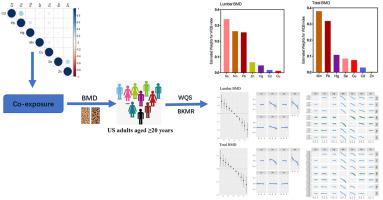Chemosphere ( IF 8.1 ) Pub Date : 2021-06-11 , DOI: 10.1016/j.chemosphere.2021.131150 Mu-Hong Wei 1 , Yuan Cui 1 , Hao-Long Zhou 1 , Wen-Jing Song 1 , Dong-Sheng Di 1 , Ru-Yi Zhang 1 , Qin Huang 2 , Jun-An Liu 3 , Qi Wang 1

|
Epidemiologic studies focus on combined effects of multiple metals on bone mineral density (BMD) are scarce. Therefore, this study was conducted to examine associations of multiple metals exposure with BMD. Data of adults aged ≥20 years (n = 2545) from the US National Health and Nutrition Examination Survey (NHANES, 2011–2016) were collected and analyzed. Concentrations of metals were measured in blood (cadmium [Cd], lead [Pb], mercury [Hg], and manganese [Mn]) and serum (copper [Cu], selenium [Se], and zinc [Zn]) using inductively coupled plasma mass spectrometry and inductively coupled plasma dynamic reaction cell mass spectrometry, respectively. The weighted quantile sum (WQS) and Bayesian kernel machine regression (BKMR) models were performed to determine the joint effects of multiple metals exposure on lumbar and total BMD. The linear regression analyses showed Pb was negatively associated with BMDs. The WQS regression analyses revealed that the WQS index was inversely related to lumbar (β = −0.022, 95% CI: −0.036, −0.008) and total BMD (β = −0.015, 95% CI: −0.024, −0.006), and Se, Mn, and Pb were the main contributors for the combined effects. Additionally, nonlinear dose–response relationships between Pb, Mn, and Se and BMD, as well as a synergistic interaction of Pb and Mn, were found in the BKMR analyses. Our findings suggested co-exposure to Cd, Pb, Hg, Mn, Cu, Se, and Zn (at or above their 50th percentiles) was associated with reduced BMD, and Pb, Mn, and Se were the main contributors driving the overall effects.
中文翻译:

多种金属与骨矿物质密度的关联:一项针对美国成年人的基于人群的研究
关注多种金属对骨矿物质密度 (BMD) 的综合影响的流行病学研究很少。因此,本研究旨在检查多种金属暴露与 BMD 的关联。收集并分析了来自美国国家健康和营养检查调查 (NHANES, 2011–2016) 的 20 岁以上成年人 (n = 2545) 的数据。使用感应法测量血液(镉 [Cd]、铅 [Pb]、汞 [Hg] 和锰 [Mn])和血清(铜 [Cu]、硒 [Se] 和锌 [Zn])中的金属浓度分别为耦合等离子体质谱法和电感耦合等离子体动态反应池质谱法。进行加权分位数总和 (WQS) 和贝叶斯核机器回归 (BKMR) 模型以确定多种金属暴露对腰椎和总 BMD 的联合影响。线性回归分析显示 Pb 与 BMD 呈负相关。WQS 回归分析显示 WQS 指数与腰椎 (β = -0.022, 95% CI: -0.036, -0.008) 和总 BMD (β = -0.015, 95% CI: -0.024, -0.006) 呈负相关,硒、锰和铅是综合效应的主要贡献者。此外,在 BKMR 分析中发现了 Pb、Mn 和 Se 与 BMD 之间的非线性剂量-反应关系,以及 Pb 和 Mn 的协同相互作用。我们的研究结果表明,同时暴露于 Cd、Pb、Hg、Mn、Cu、Se 和 Zn(等于或高于其第 50 个百分位数)与 BMD 降低有关,而 Pb、Mn 和 Se 是推动整体影响的主要因素. WQS 回归分析显示 WQS 指数与腰椎 (β = -0.022, 95% CI: -0.036, -0.008) 和总 BMD (β = -0.015, 95% CI: -0.024, -0.006) 呈负相关,硒、锰和铅是综合效应的主要贡献者。此外,在 BKMR 分析中发现了 Pb、Mn 和 Se 与 BMD 之间的非线性剂量-反应关系,以及 Pb 和 Mn 的协同相互作用。我们的研究结果表明,同时暴露于 Cd、Pb、Hg、Mn、Cu、Se 和 Zn(等于或高于其第 50 个百分位数)与 BMD 降低有关,而 Pb、Mn 和 Se 是推动整体影响的主要因素. WQS 回归分析显示 WQS 指数与腰椎 (β = -0.022, 95% CI: -0.036, -0.008) 和总 BMD (β = -0.015, 95% CI: -0.024, -0.006) 呈负相关,硒、锰和铅是综合效应的主要贡献者。此外,在 BKMR 分析中发现了 Pb、Mn 和 Se 与 BMD 之间的非线性剂量-反应关系,以及 Pb 和 Mn 的协同相互作用。我们的研究结果表明,同时暴露于 Cd、Pb、Hg、Mn、Cu、Se 和 Zn(等于或高于其第 50 个百分位数)与 BMD 降低有关,而 Pb、Mn 和 Se 是推动整体影响的主要因素. 在 BKMR 分析中发现了硒和 BMD,以及 Pb 和 Mn 的协同相互作用。我们的研究结果表明,同时暴露于 Cd、Pb、Hg、Mn、Cu、Se 和 Zn(等于或高于其第 50 个百分位数)与 BMD 降低有关,而 Pb、Mn 和 Se 是推动整体影响的主要因素. 在 BKMR 分析中发现了硒和 BMD,以及 Pb 和 Mn 的协同相互作用。我们的研究结果表明,同时暴露于 Cd、Pb、Hg、Mn、Cu、Se 和 Zn(等于或高于其第 50 个百分位数)与 BMD 降低有关,而 Pb、Mn 和 Se 是推动整体影响的主要因素.









































 京公网安备 11010802027423号
京公网安备 11010802027423号